A Comprehensive Report on Clinical Governance in Australian Healthcare
VerifiedAdded on 2021/06/17
|15
|3056
|148
Report
AI Summary
This report provides a comprehensive overview of clinical governance within the Australian healthcare system. It begins with an introduction to clinical governance, emphasizing its role in improving patient safety and quality of care, supported by the National Quality and Safety Health Standards (NQSHS). The report outlines the framework for enhancing healthcare services, addresses significant risk factors associated with poor quality healthcare, and discusses strategies for effective governance. It analyzes clinical care activities, such as mental healthcare incentive programs, and highlights the importance of data-driven decision-making and continuous improvement. The report also emphasizes the responsibilities of clinicians and other medical practitioners, as well as the role of the clinical workforce in ensuring a safe and effective healthcare environment. Furthermore, it explores the use of data outcomes, the processes of information collection, and feedback mechanisms to improve clinical care. The report also underscores the need for clear guidelines and programs to ensure smooth operations within the health sector, ultimately aiming to enhance the overall healthcare system for Australians.
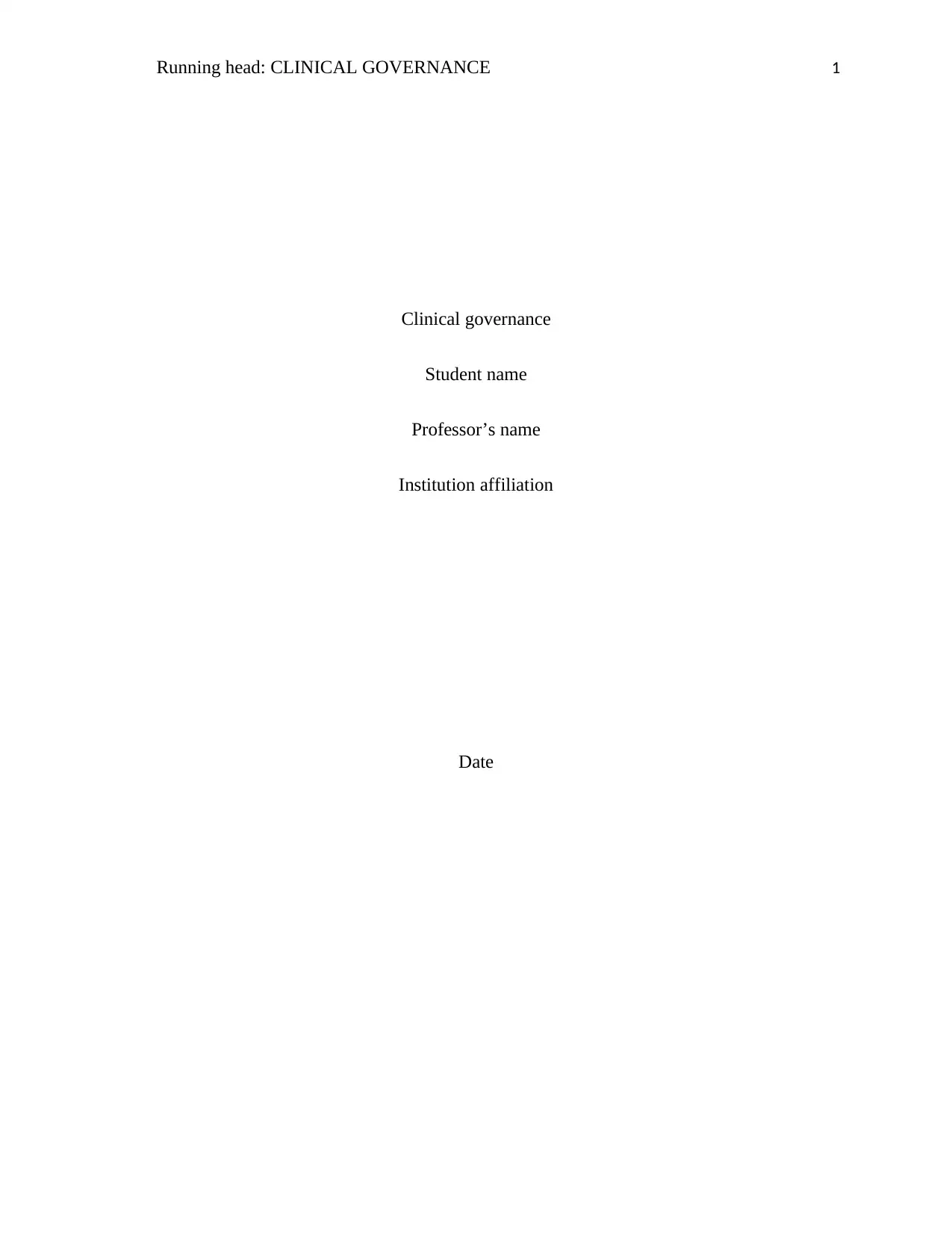
Running head: CLINICAL GOVERNANCE 1
Clinical governance
Student name
Professor’s name
Institution affiliation
Date
Clinical governance
Student name
Professor’s name
Institution affiliation
Date
Paraphrase This Document
Need a fresh take? Get an instant paraphrase of this document with our AI Paraphraser

CLINICAL GOVERNANCE 2
Clinical governance
Introduction
Clinical governance is a methodical approach to improving and monitoring safety and
quality of patients care in the National Health Service (NHS) sector. Australians have good
health outcomes from their trusted clinicians and health service organisations that provide high
quality and safe healthcare services. The health organisations offer reliable national base support
for clinical governance which is operated by the National Quality and Safety Health Standards
(NQSHS). The paper discusses the framework for improving the healthcare services through
explicit medical management. The significant risk factors and effect of poor quality healthcare
services are also demonstrated (Greenfield, Nugus, Fairbrothe, Milne & Debono, 2011).
The strategies of good governance to improve the running of healthcare centres are interpreted
through clinical discussion of a clinician care activity based on the clinical management in the
health sector. Elaboration of the importance of quality and safety care to the patient is another
issue that is addressed as a caring part of the healthcare organisation. The data outcomes and the
process of collecting the information are analysed, and a fed back in the clinical care for
improvements are well defined in the report. The paper also demonstrates the effectiveness of the
safety and quality care services to the Australians. The clear statement of the required
responsibilities of the clinicians and other medical practitioners to solidify the medical services
Clinical governance
Introduction
Clinical governance is a methodical approach to improving and monitoring safety and
quality of patients care in the National Health Service (NHS) sector. Australians have good
health outcomes from their trusted clinicians and health service organisations that provide high
quality and safe healthcare services. The health organisations offer reliable national base support
for clinical governance which is operated by the National Quality and Safety Health Standards
(NQSHS). The paper discusses the framework for improving the healthcare services through
explicit medical management. The significant risk factors and effect of poor quality healthcare
services are also demonstrated (Greenfield, Nugus, Fairbrothe, Milne & Debono, 2011).
The strategies of good governance to improve the running of healthcare centres are interpreted
through clinical discussion of a clinician care activity based on the clinical management in the
health sector. Elaboration of the importance of quality and safety care to the patient is another
issue that is addressed as a caring part of the healthcare organisation. The data outcomes and the
process of collecting the information are analysed, and a fed back in the clinical care for
improvements are well defined in the report. The paper also demonstrates the effectiveness of the
safety and quality care services to the Australians. The clear statement of the required
responsibilities of the clinicians and other medical practitioners to solidify the medical services
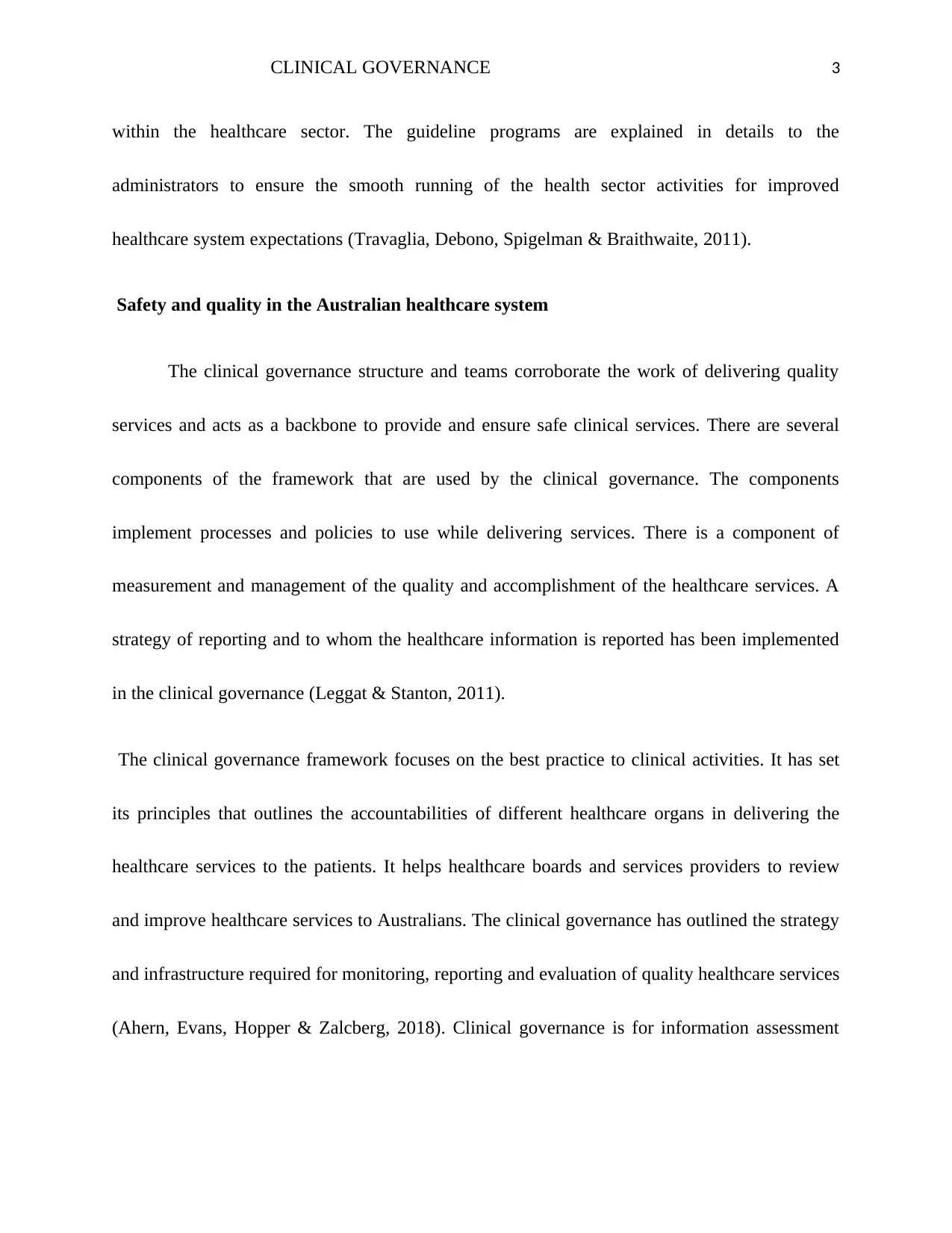
CLINICAL GOVERNANCE 3
within the healthcare sector. The guideline programs are explained in details to the
administrators to ensure the smooth running of the health sector activities for improved
healthcare system expectations (Travaglia, Debono, Spigelman & Braithwaite, 2011).
Safety and quality in the Australian healthcare system
The clinical governance structure and teams corroborate the work of delivering quality
services and acts as a backbone to provide and ensure safe clinical services. There are several
components of the framework that are used by the clinical governance. The components
implement processes and policies to use while delivering services. There is a component of
measurement and management of the quality and accomplishment of the healthcare services. A
strategy of reporting and to whom the healthcare information is reported has been implemented
in the clinical governance (Leggat & Stanton, 2011).
The clinical governance framework focuses on the best practice to clinical activities. It has set
its principles that outlines the accountabilities of different healthcare organs in delivering the
healthcare services to the patients. It helps healthcare boards and services providers to review
and improve healthcare services to Australians. The clinical governance has outlined the strategy
and infrastructure required for monitoring, reporting and evaluation of quality healthcare services
(Ahern, Evans, Hopper & Zalcberg, 2018). Clinical governance is for information assessment
within the healthcare sector. The guideline programs are explained in details to the
administrators to ensure the smooth running of the health sector activities for improved
healthcare system expectations (Travaglia, Debono, Spigelman & Braithwaite, 2011).
Safety and quality in the Australian healthcare system
The clinical governance structure and teams corroborate the work of delivering quality
services and acts as a backbone to provide and ensure safe clinical services. There are several
components of the framework that are used by the clinical governance. The components
implement processes and policies to use while delivering services. There is a component of
measurement and management of the quality and accomplishment of the healthcare services. A
strategy of reporting and to whom the healthcare information is reported has been implemented
in the clinical governance (Leggat & Stanton, 2011).
The clinical governance framework focuses on the best practice to clinical activities. It has set
its principles that outlines the accountabilities of different healthcare organs in delivering the
healthcare services to the patients. It helps healthcare boards and services providers to review
and improve healthcare services to Australians. The clinical governance has outlined the strategy
and infrastructure required for monitoring, reporting and evaluation of quality healthcare services
(Ahern, Evans, Hopper & Zalcberg, 2018). Clinical governance is for information assessment
⊘ This is a preview!⊘
Do you want full access?
Subscribe today to unlock all pages.

Trusted by 1+ million students worldwide

CLINICAL GOVERNANCE 4
from partner network to ensure all health organisations offer appropriate and safe content to
Australians.
The purpose of quality and safe health services is to ensure the governing body, clinicians and
the managers share responsibilities and are accountable for the patient's care. The significance of
proper and safe healthcare are; minimal risk to consumers, frequent monitoring and improvement
of quality clinic care, quality health services and to enhance development in the healthcare
system. The standard clinical governance outlines the deliberate strategy and actions expected to
be achieved within the healthcare sector (Nicholson, Jackson, Marley & Wells, 2012).
The standard governance states intended outcome of the organisation. It states clearly the critical
criteria with each of the principle elaborating a series of actions and items that are essential in
meeting the best health standards. The healthcare organisations, healthcare givers and patients
are involved in decision making for service planning, measuring services, developing care
models and evaluating of the healthcare system. They participate in making their own decisions
about their healthcare, know how to exercise their healthcare rights and engage in treatment
decisions. The clinical workforce is essential in delivering high quality and safe healthcare in
accordance to National Safe and Quality Healthcare standards (Melnyk, Gallagher‐Ford, Long &
Fineout‐Overholt, 2014).
from partner network to ensure all health organisations offer appropriate and safe content to
Australians.
The purpose of quality and safe health services is to ensure the governing body, clinicians and
the managers share responsibilities and are accountable for the patient's care. The significance of
proper and safe healthcare are; minimal risk to consumers, frequent monitoring and improvement
of quality clinic care, quality health services and to enhance development in the healthcare
system. The standard clinical governance outlines the deliberate strategy and actions expected to
be achieved within the healthcare sector (Nicholson, Jackson, Marley & Wells, 2012).
The standard governance states intended outcome of the organisation. It states clearly the critical
criteria with each of the principle elaborating a series of actions and items that are essential in
meeting the best health standards. The healthcare organisations, healthcare givers and patients
are involved in decision making for service planning, measuring services, developing care
models and evaluating of the healthcare system. They participate in making their own decisions
about their healthcare, know how to exercise their healthcare rights and engage in treatment
decisions. The clinical workforce is essential in delivering high quality and safe healthcare in
accordance to National Safe and Quality Healthcare standards (Melnyk, Gallagher‐Ford, Long &
Fineout‐Overholt, 2014).
Paraphrase This Document
Need a fresh take? Get an instant paraphrase of this document with our AI Paraphraser
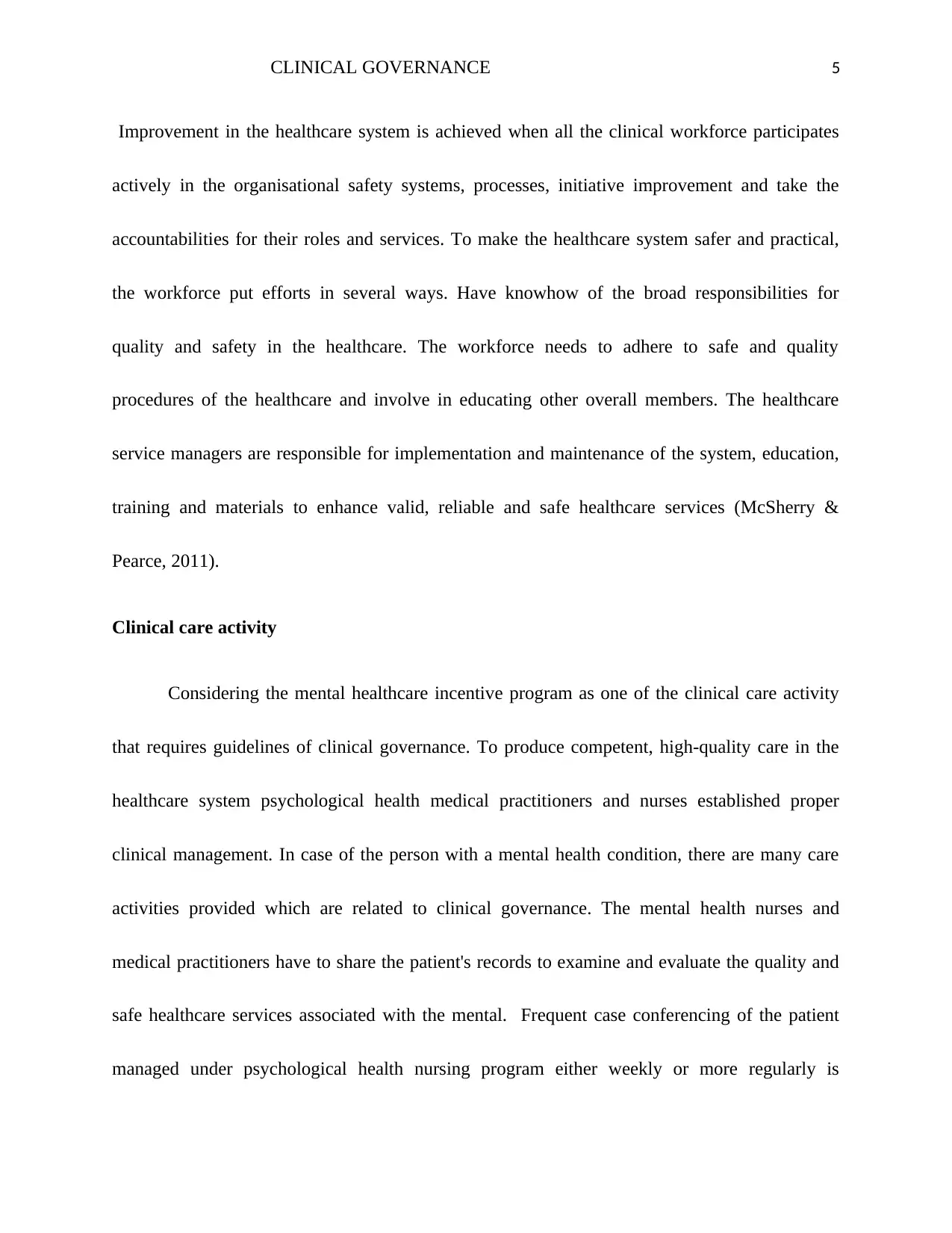
CLINICAL GOVERNANCE 5
Improvement in the healthcare system is achieved when all the clinical workforce participates
actively in the organisational safety systems, processes, initiative improvement and take the
accountabilities for their roles and services. To make the healthcare system safer and practical,
the workforce put efforts in several ways. Have knowhow of the broad responsibilities for
quality and safety in the healthcare. The workforce needs to adhere to safe and quality
procedures of the healthcare and involve in educating other overall members. The healthcare
service managers are responsible for implementation and maintenance of the system, education,
training and materials to enhance valid, reliable and safe healthcare services (McSherry &
Pearce, 2011).
Clinical care activity
Considering the mental healthcare incentive program as one of the clinical care activity
that requires guidelines of clinical governance. To produce competent, high-quality care in the
healthcare system psychological health medical practitioners and nurses established proper
clinical management. In case of the person with a mental health condition, there are many care
activities provided which are related to clinical governance. The mental health nurses and
medical practitioners have to share the patient's records to examine and evaluate the quality and
safe healthcare services associated with the mental. Frequent case conferencing of the patient
managed under psychological health nursing program either weekly or more regularly is
Improvement in the healthcare system is achieved when all the clinical workforce participates
actively in the organisational safety systems, processes, initiative improvement and take the
accountabilities for their roles and services. To make the healthcare system safer and practical,
the workforce put efforts in several ways. Have knowhow of the broad responsibilities for
quality and safety in the healthcare. The workforce needs to adhere to safe and quality
procedures of the healthcare and involve in educating other overall members. The healthcare
service managers are responsible for implementation and maintenance of the system, education,
training and materials to enhance valid, reliable and safe healthcare services (McSherry &
Pearce, 2011).
Clinical care activity
Considering the mental healthcare incentive program as one of the clinical care activity
that requires guidelines of clinical governance. To produce competent, high-quality care in the
healthcare system psychological health medical practitioners and nurses established proper
clinical management. In case of the person with a mental health condition, there are many care
activities provided which are related to clinical governance. The mental health nurses and
medical practitioners have to share the patient's records to examine and evaluate the quality and
safe healthcare services associated with the mental. Frequent case conferencing of the patient
managed under psychological health nursing program either weekly or more regularly is
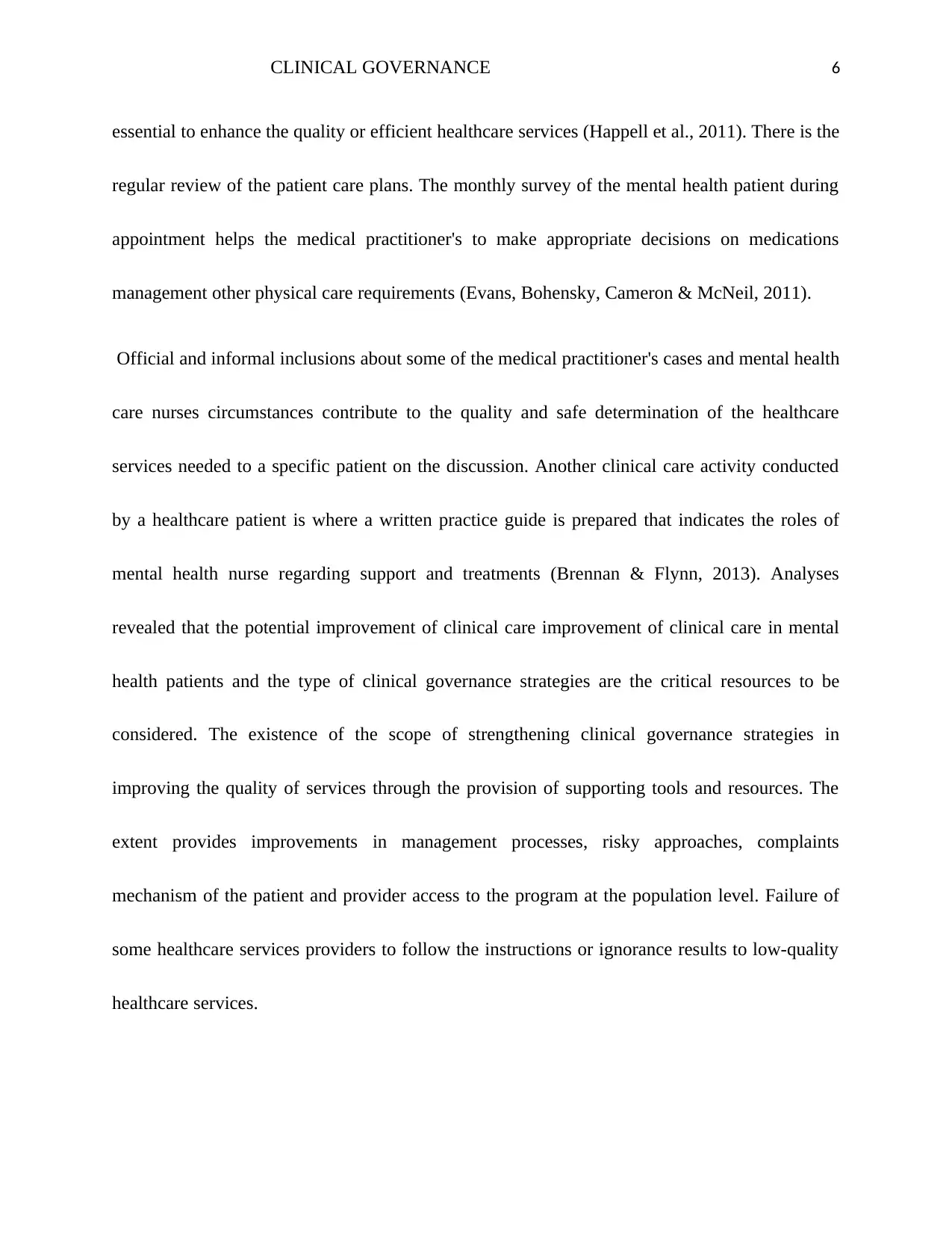
CLINICAL GOVERNANCE 6
essential to enhance the quality or efficient healthcare services (Happell et al., 2011). There is the
regular review of the patient care plans. The monthly survey of the mental health patient during
appointment helps the medical practitioner's to make appropriate decisions on medications
management other physical care requirements (Evans, Bohensky, Cameron & McNeil, 2011).
Official and informal inclusions about some of the medical practitioner's cases and mental health
care nurses circumstances contribute to the quality and safe determination of the healthcare
services needed to a specific patient on the discussion. Another clinical care activity conducted
by a healthcare patient is where a written practice guide is prepared that indicates the roles of
mental health nurse regarding support and treatments (Brennan & Flynn, 2013). Analyses
revealed that the potential improvement of clinical care improvement of clinical care in mental
health patients and the type of clinical governance strategies are the critical resources to be
considered. The existence of the scope of strengthening clinical governance strategies in
improving the quality of services through the provision of supporting tools and resources. The
extent provides improvements in management processes, risky approaches, complaints
mechanism of the patient and provider access to the program at the population level. Failure of
some healthcare services providers to follow the instructions or ignorance results to low-quality
healthcare services.
essential to enhance the quality or efficient healthcare services (Happell et al., 2011). There is the
regular review of the patient care plans. The monthly survey of the mental health patient during
appointment helps the medical practitioner's to make appropriate decisions on medications
management other physical care requirements (Evans, Bohensky, Cameron & McNeil, 2011).
Official and informal inclusions about some of the medical practitioner's cases and mental health
care nurses circumstances contribute to the quality and safe determination of the healthcare
services needed to a specific patient on the discussion. Another clinical care activity conducted
by a healthcare patient is where a written practice guide is prepared that indicates the roles of
mental health nurse regarding support and treatments (Brennan & Flynn, 2013). Analyses
revealed that the potential improvement of clinical care improvement of clinical care in mental
health patients and the type of clinical governance strategies are the critical resources to be
considered. The existence of the scope of strengthening clinical governance strategies in
improving the quality of services through the provision of supporting tools and resources. The
extent provides improvements in management processes, risky approaches, complaints
mechanism of the patient and provider access to the program at the population level. Failure of
some healthcare services providers to follow the instructions or ignorance results to low-quality
healthcare services.
⊘ This is a preview!⊘
Do you want full access?
Subscribe today to unlock all pages.

Trusted by 1+ million students worldwide
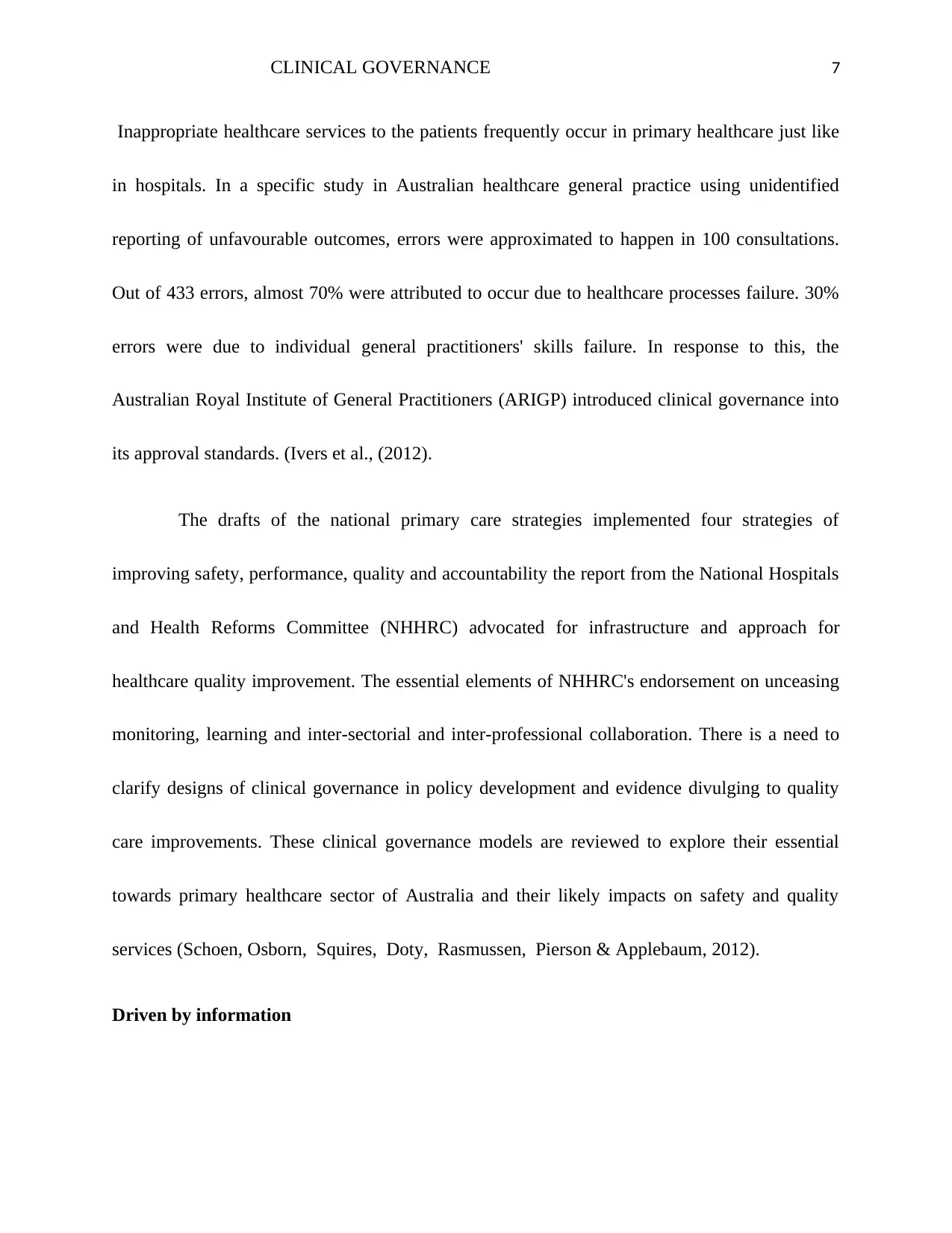
CLINICAL GOVERNANCE 7
Inappropriate healthcare services to the patients frequently occur in primary healthcare just like
in hospitals. In a specific study in Australian healthcare general practice using unidentified
reporting of unfavourable outcomes, errors were approximated to happen in 100 consultations.
Out of 433 errors, almost 70% were attributed to occur due to healthcare processes failure. 30%
errors were due to individual general practitioners' skills failure. In response to this, the
Australian Royal Institute of General Practitioners (ARIGP) introduced clinical governance into
its approval standards. (Ivers et al., (2012).
The drafts of the national primary care strategies implemented four strategies of
improving safety, performance, quality and accountability the report from the National Hospitals
and Health Reforms Committee (NHHRC) advocated for infrastructure and approach for
healthcare quality improvement. The essential elements of NHHRC's endorsement on unceasing
monitoring, learning and inter-sectorial and inter-professional collaboration. There is a need to
clarify designs of clinical governance in policy development and evidence divulging to quality
care improvements. These clinical governance models are reviewed to explore their essential
towards primary healthcare sector of Australia and their likely impacts on safety and quality
services (Schoen, Osborn, Squires, Doty, Rasmussen, Pierson & Applebaum, 2012).
Driven by information
Inappropriate healthcare services to the patients frequently occur in primary healthcare just like
in hospitals. In a specific study in Australian healthcare general practice using unidentified
reporting of unfavourable outcomes, errors were approximated to happen in 100 consultations.
Out of 433 errors, almost 70% were attributed to occur due to healthcare processes failure. 30%
errors were due to individual general practitioners' skills failure. In response to this, the
Australian Royal Institute of General Practitioners (ARIGP) introduced clinical governance into
its approval standards. (Ivers et al., (2012).
The drafts of the national primary care strategies implemented four strategies of
improving safety, performance, quality and accountability the report from the National Hospitals
and Health Reforms Committee (NHHRC) advocated for infrastructure and approach for
healthcare quality improvement. The essential elements of NHHRC's endorsement on unceasing
monitoring, learning and inter-sectorial and inter-professional collaboration. There is a need to
clarify designs of clinical governance in policy development and evidence divulging to quality
care improvements. These clinical governance models are reviewed to explore their essential
towards primary healthcare sector of Australia and their likely impacts on safety and quality
services (Schoen, Osborn, Squires, Doty, Rasmussen, Pierson & Applebaum, 2012).
Driven by information
Paraphrase This Document
Need a fresh take? Get an instant paraphrase of this document with our AI Paraphraser
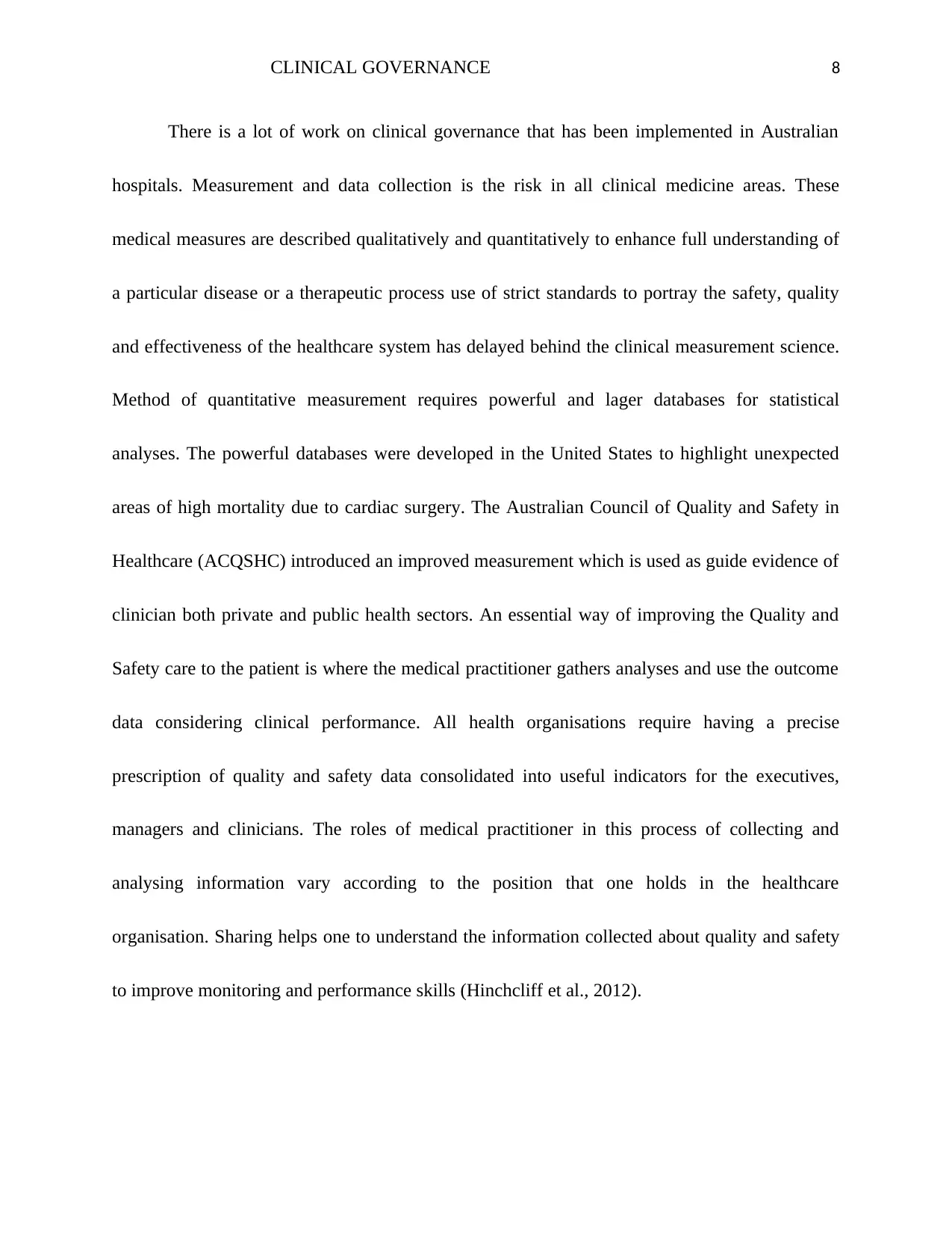
CLINICAL GOVERNANCE 8
There is a lot of work on clinical governance that has been implemented in Australian
hospitals. Measurement and data collection is the risk in all clinical medicine areas. These
medical measures are described qualitatively and quantitatively to enhance full understanding of
a particular disease or a therapeutic process use of strict standards to portray the safety, quality
and effectiveness of the healthcare system has delayed behind the clinical measurement science.
Method of quantitative measurement requires powerful and lager databases for statistical
analyses. The powerful databases were developed in the United States to highlight unexpected
areas of high mortality due to cardiac surgery. The Australian Council of Quality and Safety in
Healthcare (ACQSHC) introduced an improved measurement which is used as guide evidence of
clinician both private and public health sectors. An essential way of improving the Quality and
Safety care to the patient is where the medical practitioner gathers analyses and use the outcome
data considering clinical performance. All health organisations require having a precise
prescription of quality and safety data consolidated into useful indicators for the executives,
managers and clinicians. The roles of medical practitioner in this process of collecting and
analysing information vary according to the position that one holds in the healthcare
organisation. Sharing helps one to understand the information collected about quality and safety
to improve monitoring and performance skills (Hinchcliff et al., 2012).
There is a lot of work on clinical governance that has been implemented in Australian
hospitals. Measurement and data collection is the risk in all clinical medicine areas. These
medical measures are described qualitatively and quantitatively to enhance full understanding of
a particular disease or a therapeutic process use of strict standards to portray the safety, quality
and effectiveness of the healthcare system has delayed behind the clinical measurement science.
Method of quantitative measurement requires powerful and lager databases for statistical
analyses. The powerful databases were developed in the United States to highlight unexpected
areas of high mortality due to cardiac surgery. The Australian Council of Quality and Safety in
Healthcare (ACQSHC) introduced an improved measurement which is used as guide evidence of
clinician both private and public health sectors. An essential way of improving the Quality and
Safety care to the patient is where the medical practitioner gathers analyses and use the outcome
data considering clinical performance. All health organisations require having a precise
prescription of quality and safety data consolidated into useful indicators for the executives,
managers and clinicians. The roles of medical practitioner in this process of collecting and
analysing information vary according to the position that one holds in the healthcare
organisation. Sharing helps one to understand the information collected about quality and safety
to improve monitoring and performance skills (Hinchcliff et al., 2012).

CLINICAL GOVERNANCE 9
A senior executive member of the health organisation ensures that there is quality and
safe reporting framework within the organisation. That framework specifies the method of data
collection and how to use the information. It is the role of the chief board member to review the
data provided on the quality and safety performance of the organisation and monitor
achievements changes. The executive officials ensure that action is taken to address identified
issues from safety and quality data outcome. The senior officials decide on how the health
services of the patient can be handled in state and territory, national and other data gathering
activities like the National Registry of clinical quality and reports in contrast to the agreed
National indicators. These data collection activities provide information about the health care
services of an organisation and compare it with other similar health organisations. The
comparison gives the healthcare organisation accreditation in contribution to considerable efforts
towards improving the healthcare services. The better understanding of the patient's actual
experiences is helpful in appreciation of safe and quality healthcare services (Burgess &
Radnor, 2013).
The generated data information and real-life experiences of care providers and patients have a
unique perspective in providing an accurate picture of quality and safety performance. The
primary determinants of the safety of the patient are recognition of ways in which the health
system is organised. The senior executive to ensure the priority of improvement in performance
A senior executive member of the health organisation ensures that there is quality and
safe reporting framework within the organisation. That framework specifies the method of data
collection and how to use the information. It is the role of the chief board member to review the
data provided on the quality and safety performance of the organisation and monitor
achievements changes. The executive officials ensure that action is taken to address identified
issues from safety and quality data outcome. The senior officials decide on how the health
services of the patient can be handled in state and territory, national and other data gathering
activities like the National Registry of clinical quality and reports in contrast to the agreed
National indicators. These data collection activities provide information about the health care
services of an organisation and compare it with other similar health organisations. The
comparison gives the healthcare organisation accreditation in contribution to considerable efforts
towards improving the healthcare services. The better understanding of the patient's actual
experiences is helpful in appreciation of safe and quality healthcare services (Burgess &
Radnor, 2013).
The generated data information and real-life experiences of care providers and patients have a
unique perspective in providing an accurate picture of quality and safety performance. The
primary determinants of the safety of the patient are recognition of ways in which the health
system is organised. The senior executive to ensure the priority of improvement in performance
⊘ This is a preview!⊘
Do you want full access?
Subscribe today to unlock all pages.

Trusted by 1+ million students worldwide
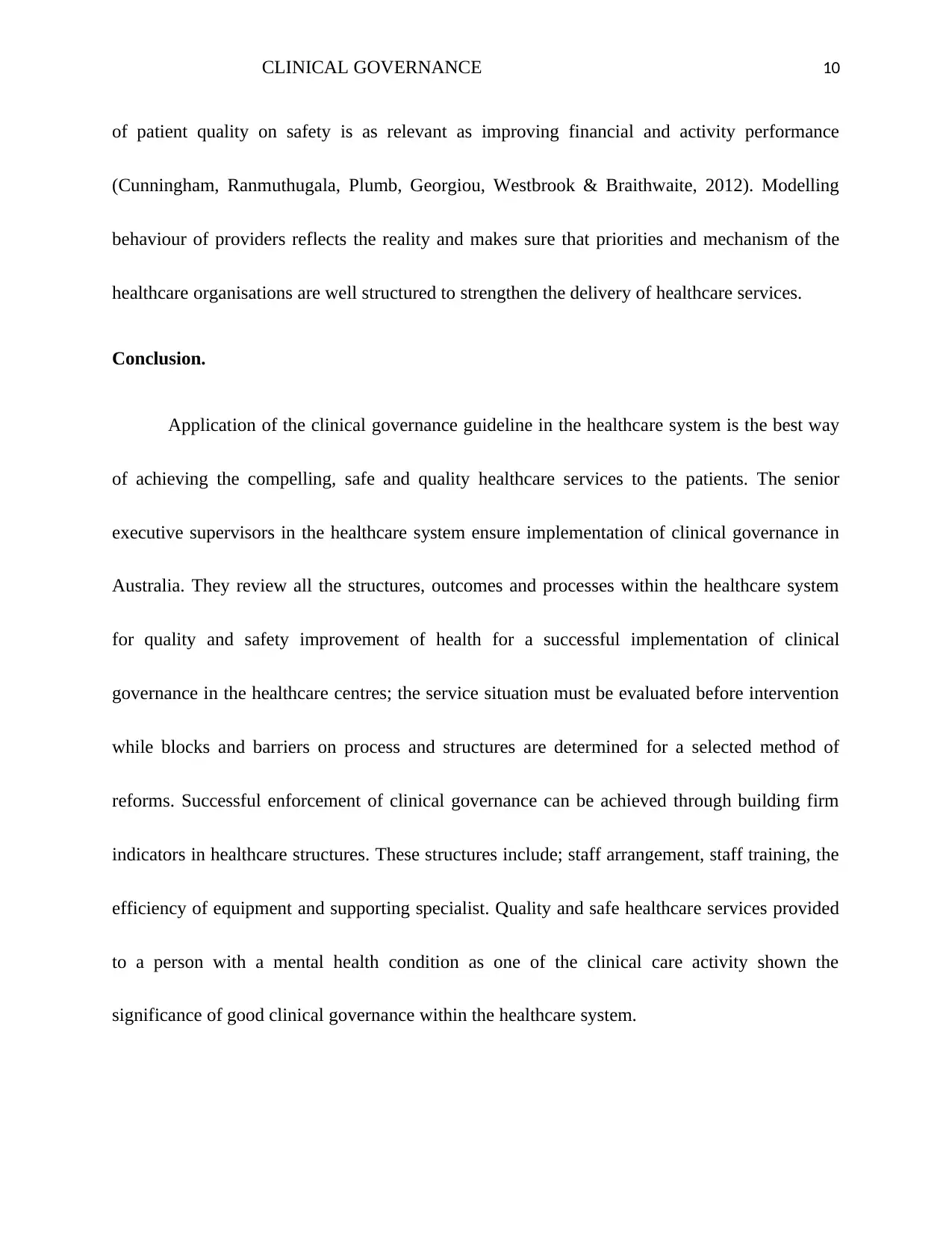
CLINICAL GOVERNANCE 10
of patient quality on safety is as relevant as improving financial and activity performance
(Cunningham, Ranmuthugala, Plumb, Georgiou, Westbrook & Braithwaite, 2012). Modelling
behaviour of providers reflects the reality and makes sure that priorities and mechanism of the
healthcare organisations are well structured to strengthen the delivery of healthcare services.
Conclusion.
Application of the clinical governance guideline in the healthcare system is the best way
of achieving the compelling, safe and quality healthcare services to the patients. The senior
executive supervisors in the healthcare system ensure implementation of clinical governance in
Australia. They review all the structures, outcomes and processes within the healthcare system
for quality and safety improvement of health for a successful implementation of clinical
governance in the healthcare centres; the service situation must be evaluated before intervention
while blocks and barriers on process and structures are determined for a selected method of
reforms. Successful enforcement of clinical governance can be achieved through building firm
indicators in healthcare structures. These structures include; staff arrangement, staff training, the
efficiency of equipment and supporting specialist. Quality and safe healthcare services provided
to a person with a mental health condition as one of the clinical care activity shown the
significance of good clinical governance within the healthcare system.
of patient quality on safety is as relevant as improving financial and activity performance
(Cunningham, Ranmuthugala, Plumb, Georgiou, Westbrook & Braithwaite, 2012). Modelling
behaviour of providers reflects the reality and makes sure that priorities and mechanism of the
healthcare organisations are well structured to strengthen the delivery of healthcare services.
Conclusion.
Application of the clinical governance guideline in the healthcare system is the best way
of achieving the compelling, safe and quality healthcare services to the patients. The senior
executive supervisors in the healthcare system ensure implementation of clinical governance in
Australia. They review all the structures, outcomes and processes within the healthcare system
for quality and safety improvement of health for a successful implementation of clinical
governance in the healthcare centres; the service situation must be evaluated before intervention
while blocks and barriers on process and structures are determined for a selected method of
reforms. Successful enforcement of clinical governance can be achieved through building firm
indicators in healthcare structures. These structures include; staff arrangement, staff training, the
efficiency of equipment and supporting specialist. Quality and safe healthcare services provided
to a person with a mental health condition as one of the clinical care activity shown the
significance of good clinical governance within the healthcare system.
Paraphrase This Document
Need a fresh take? Get an instant paraphrase of this document with our AI Paraphraser

CLINICAL GOVERNANCE 11
Regarding the points of clinical governance guarantee success in providing high quality and safe
healthcare. Clinical governance acts as a bridge between clinical approaches of healthcare staffs
and the managerial executives. Practical use of information and data in policy decisions,
productive workforce, trained staff and evaluation of health services regularly to attain the best
measurements and activity performance. All achievements from clinical governance
implementation are essential features in quality and safe services of Australian healthcare
centres. Use of organisation strategies to reduce blame culture, improving staffs' partnership,
sharing information, use of clinical governance guidelines and procedures can be useful in the
full working of clinical.
Regarding the points of clinical governance guarantee success in providing high quality and safe
healthcare. Clinical governance acts as a bridge between clinical approaches of healthcare staffs
and the managerial executives. Practical use of information and data in policy decisions,
productive workforce, trained staff and evaluation of health services regularly to attain the best
measurements and activity performance. All achievements from clinical governance
implementation are essential features in quality and safe services of Australian healthcare
centres. Use of organisation strategies to reduce blame culture, improving staffs' partnership,
sharing information, use of clinical governance guidelines and procedures can be useful in the
full working of clinical.
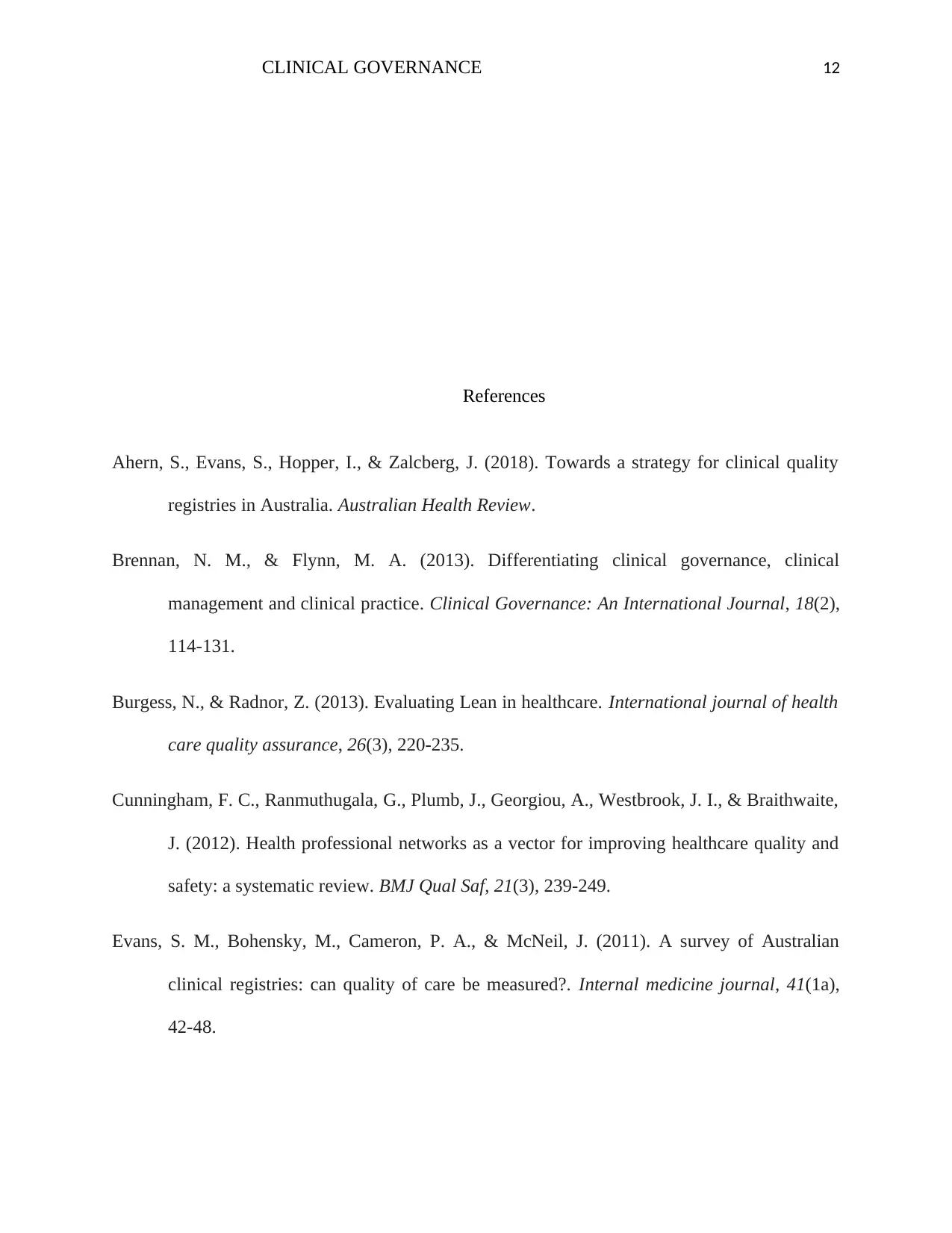
CLINICAL GOVERNANCE 12
References
Ahern, S., Evans, S., Hopper, I., & Zalcberg, J. (2018). Towards a strategy for clinical quality
registries in Australia. Australian Health Review.
Brennan, N. M., & Flynn, M. A. (2013). Differentiating clinical governance, clinical
management and clinical practice. Clinical Governance: An International Journal, 18(2),
114-131.
Burgess, N., & Radnor, Z. (2013). Evaluating Lean in healthcare. International journal of health
care quality assurance, 26(3), 220-235.
Cunningham, F. C., Ranmuthugala, G., Plumb, J., Georgiou, A., Westbrook, J. I., & Braithwaite,
J. (2012). Health professional networks as a vector for improving healthcare quality and
safety: a systematic review. BMJ Qual Saf, 21(3), 239-249.
Evans, S. M., Bohensky, M., Cameron, P. A., & McNeil, J. (2011). A survey of Australian
clinical registries: can quality of care be measured?. Internal medicine journal, 41(1a),
42-48.
References
Ahern, S., Evans, S., Hopper, I., & Zalcberg, J. (2018). Towards a strategy for clinical quality
registries in Australia. Australian Health Review.
Brennan, N. M., & Flynn, M. A. (2013). Differentiating clinical governance, clinical
management and clinical practice. Clinical Governance: An International Journal, 18(2),
114-131.
Burgess, N., & Radnor, Z. (2013). Evaluating Lean in healthcare. International journal of health
care quality assurance, 26(3), 220-235.
Cunningham, F. C., Ranmuthugala, G., Plumb, J., Georgiou, A., Westbrook, J. I., & Braithwaite,
J. (2012). Health professional networks as a vector for improving healthcare quality and
safety: a systematic review. BMJ Qual Saf, 21(3), 239-249.
Evans, S. M., Bohensky, M., Cameron, P. A., & McNeil, J. (2011). A survey of Australian
clinical registries: can quality of care be measured?. Internal medicine journal, 41(1a),
42-48.
⊘ This is a preview!⊘
Do you want full access?
Subscribe today to unlock all pages.

Trusted by 1+ million students worldwide
1 out of 15
Related Documents
Your All-in-One AI-Powered Toolkit for Academic Success.
+13062052269
info@desklib.com
Available 24*7 on WhatsApp / Email
![[object Object]](/_next/static/media/star-bottom.7253800d.svg)
Unlock your academic potential
Copyright © 2020–2025 A2Z Services. All Rights Reserved. Developed and managed by ZUCOL.





